Video Interviewing Platforms: A Buyer’s Guide for HR Teams
Recruitment is evolving at a breakneck pace. Organizations are no longer confined to in-person interviews or generic video calls, and are rapidly adopting video interviewing platforms as the new way of interviewing. Video interviewing refers to the process where candidates participate virtually in the interviews, either asynchronously (one-way) or in a live format (two-way), or engage with an autonomous AI interviewer using a dedicated platform.
Unlike traditional face-to-face live interviews, which require both the recruiter and candidate to be physically present together at the same time, video interviewing enables greater flexibility. It allows candidates to complete interviews on demand, while recruiters can review responses at their convenience.
Video interviewing platforms are designed to streamline hiring, reduce time-to-hire, and provide a consistent and engaging experience for both candidates and recruiters. These platforms are different from conventional conferencing tools, offering recruitment convenience functionalities for every step of the hiring process, from scheduling to evaluation.
This guide explores the various types of platforms, key features, advanced capabilities, and best practices, providing a comprehensive roadmap for selecting the right solution.
Types of Video Interviewing Platforms
Video interviewing platforms are not one-size-fits-all. Before making a selection, it’s important to understand the differences between platform types and how each aligns with your recruitment goals. Each platform addresses different challenges like scheduling constraints, candidate volume, the interview stage, or evaluation requirements. There are three primary types of platforms:
1. Asynchronous (One-Way) Interviewing Platform
Asynchronous, or one-way interviews, allow candidates to respond to pre-recorded questions at a time that works best for them. Recruiters can then review these responses at their convenience. These platforms are particularly valuable when hiring for high-volume roles, such as customer service or retail positions, where the sheer number of applicants makes scheduling live interviews impractical.
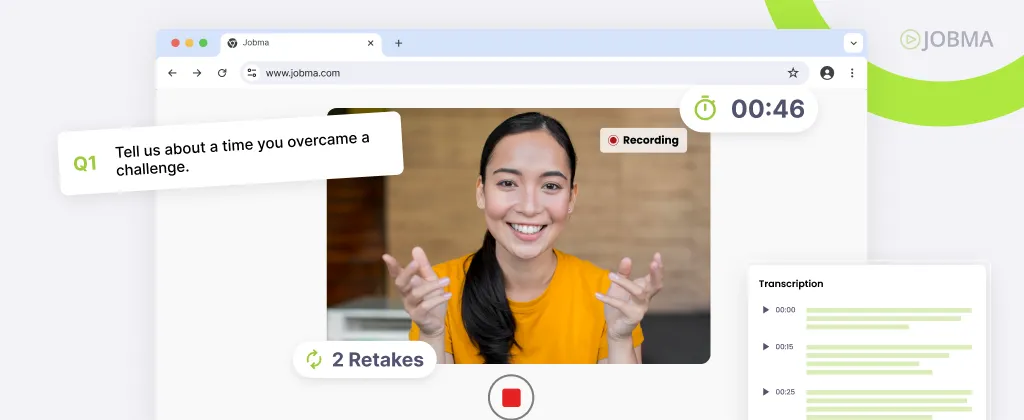
Key platform features include:
- Pre-recorded Interviews & Assessments: Recruiters create a list of questions aligned with the job description and core competencies, and candidates record their answers in a set time window. For example, you might create an assessment with five text-based questions for an entry-level marketing role, such as “Tell us about a campaign you worked on that improved engagement.” Each candidate will be required to respond to the same question in the same format for a structured evaluation. Some platforms even allow additional settings like time limits for answers (e.g., 90 seconds to respond) or the option to retake an answer before submission.
- Flexible Candidate Access: Flexible candidate access refers to the system’s ability to let candidates record their responses whenever and wherever it suits them. They simply receive a secure link, provide their email, and start the interview at their convenience. Some platforms also allow pausing between questions, so candidates can take a break before moving on to the next question. Instead of blocking calendars for dozens of calls, you can simply send out links and collect interview responses asynchronously. This creates a pipeline where candidates move forward without waiting for scheduling coordination, significantly reducing time-to-hire.
- Replay and Evaluation Tools: In asynchronous interviewing platforms, every recorded candidate response is automatically stored in the system. You can watch each video answer as many times as needed. Advanced systems may also include timestamped playback controls, slow-motion playback, and multilingual transcripts. You can rate the response inside the platform using either numerical scoring (like 1-5) or pre-set competency rubrics (such as “communication skills,” “problem-solving,” “team fit”). You can also leave written notes that are visible to other evaluators.
- Structured Assessments for Any Role: Consistency in asynchronous interviews comes from the platform’s design – every candidate receives the same list of pre-set questions with the same settings (e.g., identical time limits for each response). This means the interview experience is standardized, which is very difficult to achieve in traditional, person-to-person interviews. This is particularly powerful in high-volume hiring, such as call center recruitment or seasonal retail staffing. The platform helps level the playing field to support compliance and fairness initiatives.
2. Synchronous (Live) Interviewing Platforms
Synchronous interviews, also called live interviews, take place in real time. They resemble traditional interviews but are conducted virtually over video conferencing, allowing candidates and interviewers to interact in real time. You schedule a video call with the candidate through the platform that includes virtual waiting rooms, panel interview setups, and real-time chat for notes. Multiple team members can participate, enabling diverse input in the evaluation process.
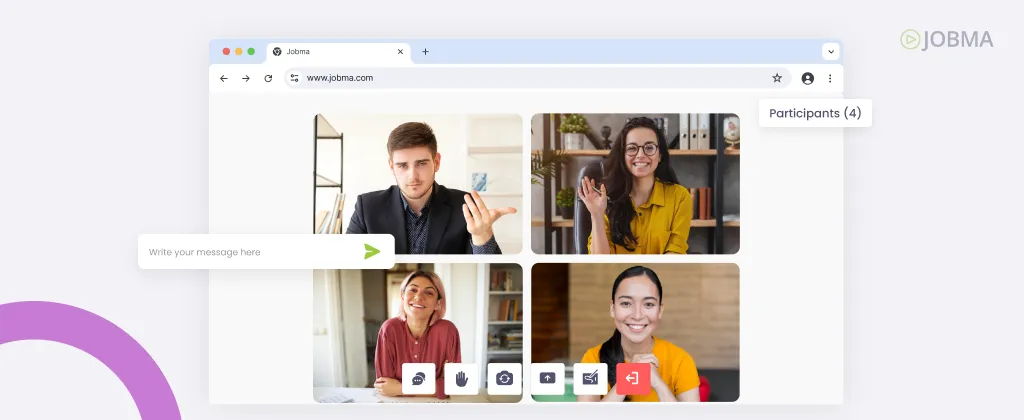
Its key features include:
- Real-time Video Conferencing: In a live interview platform, real-time video conferencing is built specifically for recruitment. Candidates enter a secure, branded, and virtual interview room, the session is automatically logged. Some platforms highlight job-related competencies, like problem-solving and communication, during the conversation.
- Panel Interview Support: Panel interviews are when multiple interviewers, who may be from different departments or locations, join the same live session with a candidate. The platform enables candidates to see everyone on screen, while the interviewers can collaborate behind the scenes using shared notes or private chat. This is particularly useful when a candidate needs to be evaluated from multiple perspectives, such as technical expertise, cultural alignment, and leadership potential.
For example, an engineering manager, an HR business partner, and a team lead might all join the same session. Instead of conducting three separate interviews, they can evaluate together, ask complementary questions, and get a holistic view in real time. - Interactive Tools: Live interview platforms also provide interactive tools like digital whiteboards, screen-sharing, and live coding environments for skill-based assessments. For example, a recruiter hiring a software engineer might open a collaborative coding editor inside the live stream, allowing the candidate to solve challenges in real time.
- Recording Capabilities: Recording tools allow live interview sessions to be securely captured, stored, and reviewed later. Instead of relying on note-taking during the call, the platform automatically saves the full video and, in some cases, generates transcripts. Recruiters can tag important moments, bookmark answers, and share the recording with colleagues who couldn’t attend the live session. In large hiring teams, these recordings allow all stakeholders to review the interview and provide their input.
Live interviews are ideal for later-stage interviews where a deeper assessment of communication skills, cultural fit, and problem-solving abilities is essential. You ask follow-up questions on the spot, clarify ambiguous answers, and observe candidate reactions.
3. Integrated Platforms
Many modern platforms combine both asynchronous and synchronous capabilities. This integrated approach allows HR teams to manage the entire interview process within a single platform, from initial screenings to final rounds.
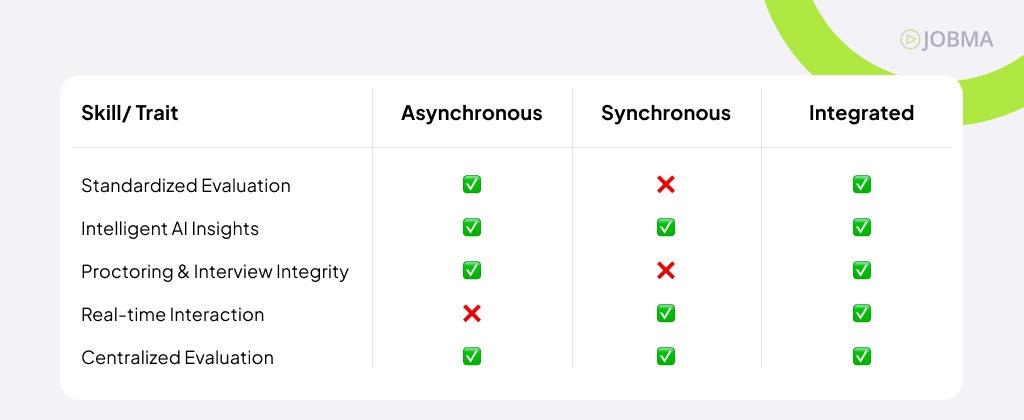
- How it works: Recruiters can create multi-stage interview workflows, beginning with one-way recorded questions for initial screenings and progressing to live interviews for top-performing candidates. All candidate information, interview recordings, and evaluation notes are stored centrally.
For example, a global technology company might first invite applicants for an asynchronous screening, shortlisting the top 10%. These candidates could then be automatically scheduled for a live panel interview through the same system. This eliminates the hassles of exporting candidate data or toggling between multiple platforms. - Key benefits: Integrated platforms are particularly valuable for organizations seeking scalability and efficiency across varied hiring needs, offering a unified solution for recruiters while providing a smoother, more consistent candidate journey. It provides flexibility, reduces the need for multiple tools, and simplifies the evaluation process. Teams can scale hiring processes without losing consistency or quality. Candidates benefit from a seamless experience that maintains engagement across multiple interview stages.
Features to Consider Before Choosing a Platform
The core features and functionalities that a platform offers directly impact how smoothly HR teams can manage candidate pipelines, evaluate applicants fairly, and make timely decisions. Without the right features, even the most sophisticated video interviewing platform can become cumbersome, creating bottlenecks instead of streamlining the process. Let’s take a look at the features you need to consider before making your final decision.
1. Automated Scheduling
Scheduling interviews manually is often one of the most time-consuming aspects of recruitment. In 2024, recruiters spent 35% of their time on interview scheduling. Back-and-forth emails, calendar conflicts, and missed time slots can stretch over days, slowing down the hiring process.
Interviewing platforms automate scheduling by integrating with your calendar system. You set your availability slots, and candidates can then select the time that works best for them using a secure link. If a candidate is in a different time zone, the system automatically adjusts available times to their local time. This feature also sends automatic reminders to candidates and interviewers, reducing no-shows. It allows you to handle high-volume recruitment efficiently without hiring additional administrative support.
2. Interview Recording
Recording interviews is more than just storing video responses, it’s about creating a transparent and collaborative evaluation process. In a distributed hiring team based out of different locations or time zones, it’s impractical to conduct live interviews with every participant present.
With interview recording, the platform automatically saves each candidate’s responses, allowing multiple team members to review, annotate, and score interviews at their convenience. For example, a hiring manager in New York can review a candidate’s coding challenge, while a team member in London evaluates communication skills, ensuring that all aspects of the candidate’s performance are assessed comprehensively. It also helps maintain compliance and support feedback loops.
3. Customizable Templates
One of the biggest challenges in recruitment is maintaining consistency across multiple roles, candidates, and hiring managers. Customizable templates solve this problem by allowing you to design structured interviews tailored to specific positions and skills. For example, a software engineering interview might include coding challenges, situational problem-solving questions, and behavioral prompts, whereas a sales role interview focuses on client engagement scenarios, objection handling, and persuasive communication.
You can also define scoring rubrics within each interview, ensuring each candidate is evaluated objectively and against the same criteria. This not only reduces the risk of unconscious bias but also accelerates the evaluation process, as these tried-and-tested question sets can be reused for future hiring cycles.
4. Collaboration Tools
Hiring decisions are rarely made by a single individual and require input from multiple stakeholders. Collaboration tools within video interviewing platforms allow your team to consolidate evaluations efficiently.
Imagine a panel interview where three hiring managers need to assess a candidate’s technical knowledge, communication style, and cultural fit. Collaboration tools like access to recorded interviews, the ability to share, rate, and comment on interviews, enable each panelist to leave feedback, and highlight strengths or concerns directly within the platform.
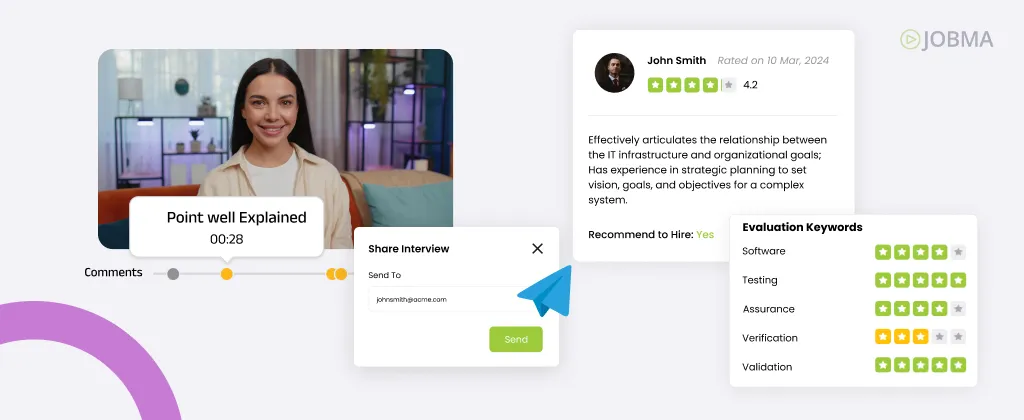
Key collaborative tools to look for:
- Shared dashboards and reports
- Threaded notes and comments that your team can view
- Integrated scoring
- User-level access to interviews, evaluations, and the platform as a whole
By fostering collective decision-making, these tools enable organizations to achieve more balanced and informed hiring outcomes, enhance accountability, and reduce the risks of biased or subjective judgments.
5. ATS Integrations
Integrating a video interviewing platform with your Applicant Tracking System (ATS) transforms recruitment from a fragmented process into a seamless, centralized workflow. This integration ensures that candidate information, resumes, interview responses, feedback, and assessment scores flow automatically between systems, eliminating the need for repetitive manual data entry. So, it’s important to look for a platform that seamlessly integrates with your existing ATS, ensuring smooth implementation and reduced need for elaborate training for your team.
6. Security and Compliance
To ensure security and integrity in your hiring workflow, the video interview platform you choose must comply with candidate data protection measures. This is crucial to ensure that candidate information and video recordings are safeguarded against unauthorized access, breaches, and misuse.
Check for robust security measures, including end-to-end encryption and data storage, to ensure that data is protected at every stage.
Regulatory compliance cannot be overlooked. Platforms must adhere to global data and privacy protection laws like the General Data Protection Regulation (GDPR), the California Consumer Privacy Act (CCPA), the Illinois Artificial Intelligence Video Interview Act (AIVIA), and other local or industry-specific data protection standards.
By prioritizing security and compliance, you not only protect sensitive data but also enhance candidate trust and demonstrate a professional, responsible approach to recruitment.

7. Scalability
As organizations grow and hiring needs change, a video interviewing platform must be able to scale smoothly. Platforms built on modern, cloud-based architecture can handle increasing numbers of candidates, interviewers, and simultaneous interviews without slowing down or facing disruptions. This design allows different parts of the platform, like scheduling, video streaming, and assessments, to expand independently, so high-volume processes are completed without bottlenecks.
Key aspects include:
- Flexible Cloud Infrastructure: Resources automatically adjust to handle peak hiring periods, keeping the system fast and reliable.
- Modular Design: Features like AI scoring, video recording, or reporting work independently, so updates or scaling one feature don’t affect the rest.
- Quick Setup and Integration: The platform can be implemented faster and integrated with other HR systems more easily than traditional, rigid platforms.
- Ease of Use at Scale: Teams can add more recruiters, panelists, or candidates without extra IT support or extensive training, so workflows can expand as hiring strategies evolve.
Imagine a rapidly growing company hiring hundreds of employees each quarter that needs to maintain smooth interview scheduling and sharing, and collaborative evaluation, even as volumes rise. Scalable platforms ensure that both recruiters achieve this, no matter how big the hiring campaign becomes.
8. Candidate Experience
Other than the role itself, hiring experience plays a crucial role for candidates in selecting their next employer. So, the video interviewing platforms you choose must have built-in experience features to enhance candidate engagement.
Key elements include:
- Flexibility to add your company logos, welcome videos, and tailored instructions to reinforce your employer brand and make candidates feel informed and welcomed.
- Compatibility with mobile, laptop, and tablet devices, so candidates can participate from any device without dealing with technical compatibility issues.
- Practice questions, countdown timers, interview reminders, and on-screen instructions to help candidates present their best selves.
9. Technical Assessments
Technical roles, like software engineers, testers, AI experts, programmers, etc., demand practical evaluation beyond resumes or traditional interviews. Modern video interviewing platforms embed coding challenges to simulate real-world tasks and measure practical skills accurately.
Core capabilities include:
- Live Coding Environments: Candidates write and test code directly within the platform, allowing evaluators to see problem-solving methods in real-time.
- Interactive Flowcharts: Candidate attempts scenario-based tasks so you can assess their logical thinking, creativity, and communication.
- Integrated Evaluation: Scores and comments on candidate responses for streamlined decision-making.
For instance, a software company hiring developers can use these tools for coding skills assessment, collaboration skills, and technical knowledge in one platform. Instead of relying on paper-based tests or unverified skill claims, it allows you to see candidates’ real capabilities, ensuring more reliable hiring decisions.
10. AI-Powered Assistance
The future is AI. So, it’s important to ensure that the platform you choose is in line with the technological changes and offers AI-powered features to enhance efficiency while supporting human decision-making. Most common AI capabilities offered by advanced platforms include:
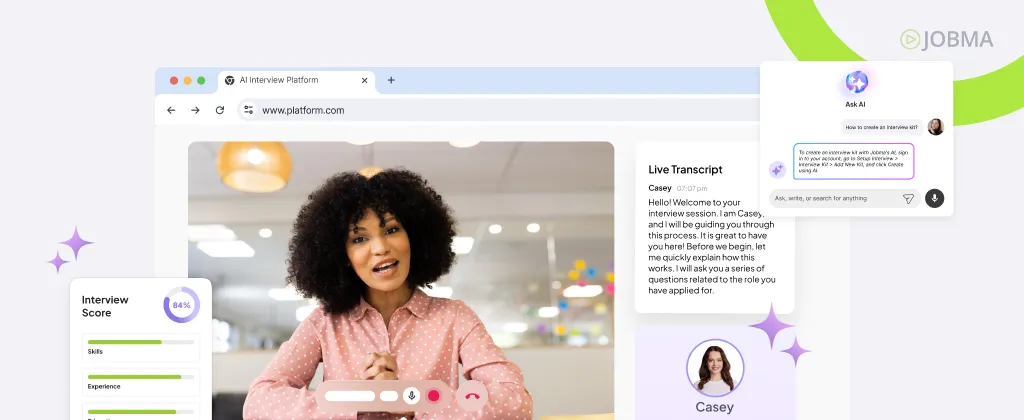
- Transcription and Summaries: AI generates transcripts and concise summaries of interview responses, making review faster and more accurate.
- Candidate Scoring Suggestions: Algorithms highlight key skills, sentiment, and response quality, providing additional insight for evaluators.
- Trend Analysis: AI can identify common patterns across multiple interviews, helping recruiters spot high-potential candidates or training gaps.
- Ethical AI: Commitment to responsible, transparent, and fair use of AI, as a support agent, while hiring decisions are primarily handled by human recruiters.
Jobma: Your All-in-One Hiring Solution
Jobma is a unified platform to help HR teams manage both asynchronous and synchronous interviews. The platform features include AI-assisted interviews and insights, technical and skill validation assessments, and role-based access for efficient team collaboration. It also comes with automated scheduling to reduce recruitment-candidate coordination challenges and pre-recorded multi-format interviews to allow teams to review and collaborate on candidate evaluations at their convenience. Customizable question sets and collaborative rating tools enable fair, consistent evaluation of every candidate.
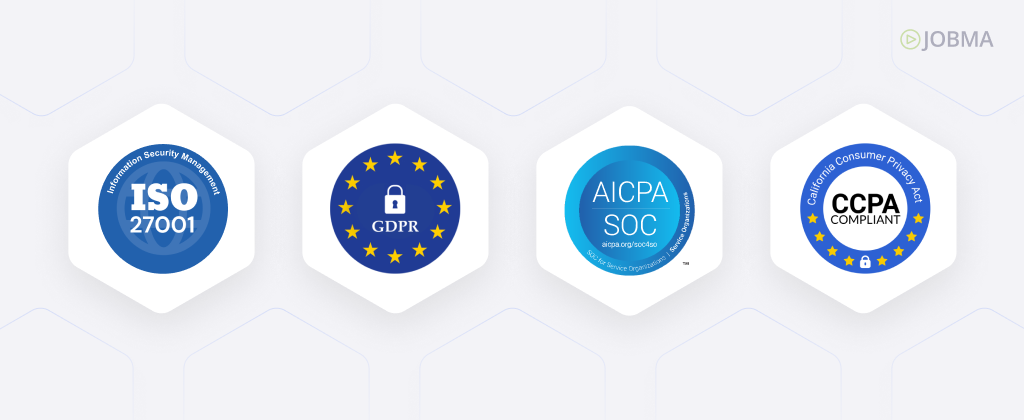
The platform is compliant with GDPR, ISO, and CCPA regulations, making hiring secure and bias-free. HR teams benefit from enhanced candidate experience through custom branding, multichannel invites and reminders (email, SMS, and in-app), and an easy-to-use platform interface.
The Future of Interviewing
Modern hiring platforms provide powerful tools that empower HR teams to make more informed, efficient, and consistent hiring decisions. By automating scheduling, candidate evaluation, and assessment, recruiters streamline workflows, reduce administrative work, and maintain a structured recruitment process. Leveraging such platforms allows organizations to balance speed, quality, and consistency, ensuring that both recruiters and candidates benefit from a smoother, more professional hiring journey.




